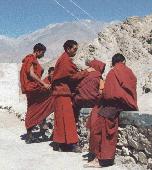
Updated vendredi 10 décembre 2004 17:30
Notes for the attention to
Persons quite particularly attracted(enticed) by the
Tibetan Buddhism
Copyright © Sâdhana
The U.B.L.F is anxious quite
particularly, in the beginning of this web page, to underline firmly that the
very painful politico-religious situation in the Tibet, being able to give to
confusion due to the complex disinformation which surrounds it, with
its prize of reprehensible atrocities is not unique event
in Asia. One forgets too easily the massacre (92 %)
Cambodian monks by the red Khmers, massacres of whom one has never spoken or even less made, as much beating as for
that of the Tibetan monks, because, it is also about monks, even more
fundamentally Buddhists, that it is very clear! 
In countries where the military regimes as well as totalitarian reign without division, monks as Burmese as Laotian, that viêtnamiens, even Chinese are not safe and their arrests are commoncurrencies, crossed arrests the major part under silence and unknown by the world opinion. If the Tibet holds the height of the pavement at present in this " désilencisation ", it is because of the excellently strategic and hydrological position (the Indus, the Ganges, the Brahmaputra, the Salveen, the Mekong, the Yang Tse and the Yellow River take there their sources) that this country occupies in the Asian continent. Who detains the water detains the life, quite as in the Middle East the plateau of Golan, and the Kurdish pseudo-territories...
England (hegemonic colonizer in the subcontinent is Asian on the impulse of Disraëli, Prime Minister of queen Victoria-Impératrice of India) knows about it something: having steered to him, by fear of the colonialist aims of the Russians and by intervention forced during the agreement of Simla in 1914, the access of League of Nations (precursor of the current U.N.O) as well as that in its independence by putting him without knowing its full will indirectly under the potential suzerainty of China which did not ratify this agreement returning her of swears void. A height, while in 1948, same England creates, ex nihilo, the state of Israel, two weights, two measures, isn' t Mr Disraeli...?. Then, let us remain objective and let us be completely conscious that in the other countries, there are prisoners of religious beliefs which are briefly executed, it in the most total indifference and the ignorance.
This settling done with an informative rigour which the U.B.L.F on no account wants to abandon, let us return in to the present subject. With one quite Buddhist objectivity and a tolerance, excluding not at all a " just vision ", the U.B.L.F is anxious also to clarify different points concerning the " Tibetan Buddhism or Vajrayâna ", so fashionable at present and the distribution of which in West (affects considerable proportions (according to countries more than 60 % of the Buddhist centres, any confused schools). We are anxious also to warn, according to the " just difference ", the persons who would be attracted(enticed) by the esotéric, pronounced and underlying side, of this "shape" of Buddhism; this according to various elements which one finds quoted in Alexandra David-Neel's multiple papers, nobody nec more expert in the subject, in consideration of its Tibetan experiments and especially the adoption of the llama Yongden. The other authors mentioned it so widely.
Returning to Vajrayâna or vehicle of the Lightning (initially the lightning brandished by the Indian god Indra), it is generally known that it is the only Buddhism must to be qualified of and by its national origin, because one never speaks about the Sri Lancan, Thai, Cambodian, Laotian Buddhism, viêtnamien, or even Chinese, but rather about the Tch' the year, the Zen, the Jodo Shinshû, the Nichirenshû, the Shingon, etc.
So, the expression Tibetan Buddhism already introduces a confusion by the mixture which is done between the Tibet and the religion Buddhist. Do not forget that the Buddhism became a religion which towards the IId century p.. J-C. Indeed, the théravadine tradition or ancient was much more a philosophy of life, passed on by the monks and applied strictly by them in convents. It was so the unique privilege of a clergy worried of immortalizing the original educations of the Buddha, realized man who was on no account either a god, or a divinity, by defending itself on the contrary.
As in any spiritual succession, dissensions in the monastic order began to demonstrate themselves and, between a certain laxness and an almost fanatical fundamentalism both condemned persons by Buddha himself, a tendency (that of the mahâsanghika) was born; tendency in which Sangha, reserved until then only for the monks, could get bigger to the laymen, the Mahâsangha. These less evolved spiritually than the monks need supernatural, miracles, superstitions to believe, to support the applications of the moral and philosophic principles, inheritances of the monastic life.
It is from this moment, that the Buddhism, of initial philosophy, Way towards the Wisdom that it was, is going to become religion. According to his territorial extension, he acclimatizes local faiths by setting up, in divinities, the upholders of the answers to the metaphysical questions emitted by the common run of people. One sees then being outlined a Buddhist pantheon, blooming of divinities more terrifying and wrathful than openly peaceful, images intended to strike the imagination of the believers or regular customers, sought in the observance of the rules and especially their " material benevolence " towards the monks.
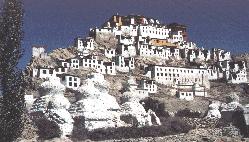
That one feels reassured and that one accuses us not of focusing our diatribe on this Tibetan Buddhism, all the naming and more or less terrifying representations (hell, purgatory...) and demonic (Satan, Bélzébuth, Lucifer, Devil...) Westerners were widely exploited, in the same sense, by the various western clergies. That it is naturally that the U.B.L.F tries orfeels), in front of the fervour and of the devotion of the faithful natives, the bigger respect than towards a certain "clergy", a holder of the faiths in which they enfeoff them and more worried of protecting the power and its advantages that the other matter (this is valid for many of the other religions or religious forms, that it is very clear!).
Who says philosophy, then
religion implies necessarily texts founders. Soûtras or sermons initial of
the Buddha, gives way gradually to comments, sastras or abidharmas,
and one sees blooming(prospering), during of numerous centuries, canonical texts
which are 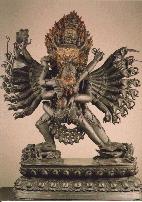 by
no means of the mouth of the Buddha, seen that they were or "breathed"
by "divinities" such Manjushri, Avalokiteshvara,
Samanthabadra, Maitreya,
Târâ (comparable in the Virgin Mary of the Catholics) consists
under " illuminatrice inspiration " by great masters, as Prajñâ-pâramitâs,
even most that famous Sadharma-pundarika soûtra - Soûtra of the
Lotus of the Good Law, basic pillar of Mahâyâna or Big conveys (soûtra
who is not certainly of the mouth of the Buddha, although one can support
it...).
by
no means of the mouth of the Buddha, seen that they were or "breathed"
by "divinities" such Manjushri, Avalokiteshvara,
Samanthabadra, Maitreya,
Târâ (comparable in the Virgin Mary of the Catholics) consists
under " illuminatrice inspiration " by great masters, as Prajñâ-pâramitâs,
even most that famous Sadharma-pundarika soûtra - Soûtra of the
Lotus of the Good Law, basic pillar of Mahâyâna or Big conveys (soûtra
who is not certainly of the mouth of the Buddha, although one can support
it...).
This term of soûtra will apply, afterward , on top of the initial sermons, more collectively in texts considered as canonical by the various Buddhist schools. It emerges that almost totality of soûtras on which bases the doctrine of Mahâyâna are the fact of anonymous authors and therefore, not at all the Buddha himself. The most known example is the soûtra of Houei-Neng's stage, sixth patriarch of the Ch'an soûtra for which the author is known to us, exception which confirms the rule...
Let us remind that the Buddhism arrived late at the Tibet, more of 1 ' 000 years after the death of the Buddha, towards Vllème s Indeed, king Songtsen Gampo (unifying of the Tibet and creator of the Tibetan alphabet) married a Nepalese princess and a Chinese princess, both soaked(filled) of Buddhism; by proof of love, he imported it in the Tibet and made build different temples among which the famous temple of Jokhang, in the center of the town of Lhasa.
It was only hundred years later that the Tibet lives Padmasambhava's arrival, magician, boss are Tantras and thaumaturge, from Odyana (at present northeast of Pakistan), revered by all the Tibetan as Guru-Rinpoché, the precious boss. Buddhist monk came to bring his "powers" to Shantarakshita, respectable whose learning had been worth him(her) the favours of king Trisong Détsen and who had been invited to spread the Buddhism in the Tibet, in spite of the wild opposition of Bönpos which saw danger in the house. He would have left termas or secret papers, carefully hidden, so that they are revealed according to their discovery by tertöns, or discoverers of secrets.
The big following event comes from monks Indian Kamalashila (school of the Progressive awakening) and Chinese Hoshang (school of the awakening Subitiste); further to their memorable debate, it was the Indian Buddhism which was proclaimed religion of state, increasing so the vindication of the Chinese, invaded repeatedly by the Tibetan armies during long periods, even to their capital of then, Tchang'AN. Do not omit that the Tibetan were in turn invaded by Mongolian and Manchu.
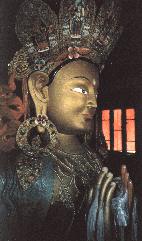 It
was then, in 1042 , the second distribution of
the Buddhism by Atisha, master as well are soutrâs whom(that) are tantras,
inspirer of the sect of Kadampas (those that follow the word of the
Buddha literally... Check?). It is as well in this time when one sees, with Drogmi,
the foundation of the tradition of Sakyas, with Marpa-le-traducteur,
Milarepa and its follower Gampopa the Kagyupa school, without forgetting
that of Nyingmapa " the former "(ancient) already pre-existent.
In this intervening period, one sees the highlight of Sakyas, and it is only at
the end of 14th with Tsongkhapa, big reformer and founder of the
school Guélugpa, " school of the virtuous way " that the decadent
Buddhism resumes of its authenticity and its morality. It is of their school
that comes Dalaïs-lamas. For this period covering some centuries, one
sees the forming(training) of different tendencies: Drigungpas, Jonangpas,
Karmapas, Shangpas, Shamarpas, Drugpa Kagyu (among eight kagyupas
grammar schools, only school to have spread out, moreover...).
It
was then, in 1042 , the second distribution of
the Buddhism by Atisha, master as well are soutrâs whom(that) are tantras,
inspirer of the sect of Kadampas (those that follow the word of the
Buddha literally... Check?). It is as well in this time when one sees, with Drogmi,
the foundation of the tradition of Sakyas, with Marpa-le-traducteur,
Milarepa and its follower Gampopa the Kagyupa school, without forgetting
that of Nyingmapa " the former "(ancient) already pre-existent.
In this intervening period, one sees the highlight of Sakyas, and it is only at
the end of 14th with Tsongkhapa, big reformer and founder of the
school Guélugpa, " school of the virtuous way " that the decadent
Buddhism resumes of its authenticity and its morality. It is of their school
that comes Dalaïs-lamas. For this period covering some centuries, one
sees the forming(training) of different tendencies: Drigungpas, Jonangpas,
Karmapas, Shangpas, Shamarpas, Drugpa Kagyu (among eight kagyupas
grammar schools, only school to have spread out, moreover...).
Small reminder on four Tibetan schools " buddhiquely ", in order chronological:
- Nyingmapa or the former,
based in the IXth following the given impulse a
century before by Padmasambhava.
The big figure Nyingmapa was among others recently Dudjom and Dilgo
Kientsé rinpochés.
- Sakyapa, those of the grey earth of Sakya's convent by Könchog Gyelpo, in the XIth. Their current spiritual leader is S.S. Sakya Tenzin. Their vocation is especially medicinal.
- Kagyupa, those of the oral transmission by Gampopa, in the XIIth - their leader is S.S Karmapa, XVIIth in the order of chalk-lining. They are recognized to be the official and licensed "missionaries" of Boudhisme. This school is subdivided into eight sub-schools as aforesaid.
- Gelugpa, said the virtuous, by the big reformer Tsongkhapa, in the XVth and from which arise the Dalai Lama, the incontested leaders of this Tibetan Buddhism.
The current Dalai Lama added to it, during the last meeting Inter-traditions of May, 97 to Karma-Ling, that of Bönpos as the school of " orants ", assimilating it to the other Buddhist schools, of which to lose Tibetan sound of it... Let us note that certain bosses, particularly realized, transcent these differences.
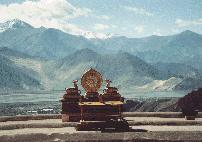
Because we have already quoted her(it), give the word to a lady who particularly well knew the Tibet before its invasion by Chinese, in the occurence, Alexandra David-Neel who does not hesitate moreover to use(employ) the word Lamaism to indicate(appoint) the religion reigning in the Tibet
Religious life in the Tibet?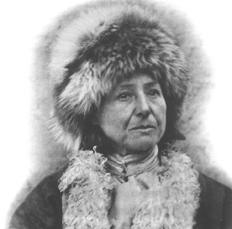
ADN - I believe to have to answer not.
- And what will you say to me? What mean so these immense convents from which any shelter more than ten thousand monks? What mean these hermits about whom you speak to us in your books, these hermits who live in caves on high mountains, plunged into continual considerations ? All this do not denote of the religion?
ADN - I answer not! In the Tibet, it stands out from the magic or from the philosophic and psychological research. All the Tibetan rites are for magic tendencies. It is there of very artless and it is there of very subtle... To force the God or the devil is an act of magic. It is to confront him, to try to do his her servant of it. It does not look like the prayer, it has nothing of monk... A big quantity of Tibetan rites aims so at obtaining from a way or from the other one, for a personal profit at first, then possibly the altruistic, the competition of extra-human personalities. At least, and so the common of the Tibetan includes these rites.
ADN - All the Tibetan say themselves Buddhists and believe that they are it, whatever are the deformations that they were able to make undergo in the doctrine of the Buddha well then that they profess opinions and devote to practices formally condemned by the Buddha...
ADN - Nobody is need to say that aspects, that Tantrisme dresses(takes on) there, differ according to the degree of culture of the individuals, but in a general way one can say that Tantrisme of the Tibetans is similar in the magic in its superior degrees and goes down until a sort of witchcraft among the ignorant and always full masses of the faiths chamanistes which dominated in the Tibet before the introduction of the Buddhism...
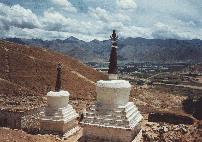 ADN
- Padmasambhava and his successors disputed Böns, but especially
to take their place as official clergy enjoying the royal favour. The kind of Buddhism which they imported was very unorthodox...
ADN
- Padmasambhava and his successors disputed Böns, but especially
to take their place as official clergy enjoying the royal favour. The kind of Buddhism which they imported was very unorthodox...
ADN - The monks do not live in community. Each of them has the particular flat. The big llamas occupy of real palace... The Tibetan monks do not make wish of poverty. Them some receive a pension of their family, the others possess lands or cattle, the others place some money in the business...
ADN - The recitation singed by sacred books is made with a very grave voice. Those that are very learned in this subject will say you that this song was calculated to produce certain particular soundwaves intended to produce special effects. The monks shake, also , by moments bells and a sort of tambourine; all this has a magic meaning and aims to obtain effects by the combination of vibrations of sounds. It is of the magic...
ADN - In West, completely erroneous notions always circulate about the Dalai Lama whom one continues to call " Popes of the Buddhism " or " reincarnation of the Buddha ". It is necessary to note from the very beginning that the skill, the energy and the success in the temporal business were particularly appreciated among the members of the sect which composes the clergy of state under the patronage of Dalaïs-lamas today. It is however only in the 16è century, in 1578 when Dalai Lama's title was conferred on the third successor of Gedun Droub by the Mongolian emperor Altan Khan... It is only the fifth Dalai Lama who proclaimed himself the " tulku " or Tchenrézigs ( Avalokiteshvara's ) reincarnation, the Lord infinitely feeling sorry for the " penetrating vision "...
ADN - As soon as the sect of the " yellow hats " got over it by means of Mongolian leaders and their troops, convents " Red hats " were plundered. On both sides, one tortured, one massacred (the bloody anecdotes do not miss about potentates' character confirmed certain high dignitaries including even of one of the previous Dalai Lama, in the respect, in particular , of Tachi Lama... Nd-UBLF)
ADN - by using address, Chinese would have doubtless managed to strengthen their suzerainty of ancient date on the Tibet. They did not know how to understand it... (This text was written in 1933, amazing, it is not...)
Concerning Bardo-thodol
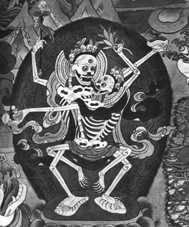 ADN
- This practice is not really a Buddhist; the origin can be found in
religions of Böns, a Tibetan branch of Taoïsme which prevailed in the Tibet
before the introduction of the Buddhism in the country and in which the
doctrines got involved with those of the Buddhism. Before the preaching of the
Buddhism in the Tibet, the religion of the Tibetan was a sort of shamanism
called(mentioned) Bön who appears to us, through the old
traditions, as having been based on the magic...
ADN
- This practice is not really a Buddhist; the origin can be found in
religions of Böns, a Tibetan branch of Taoïsme which prevailed in the Tibet
before the introduction of the Buddhism in the country and in which the
doctrines got involved with those of the Buddhism. Before the preaching of the
Buddhism in the Tibet, the religion of the Tibetan was a sort of shamanism
called(mentioned) Bön who appears to us, through the old
traditions, as having been based on the magic...
Although he can happen, we should content, for the moment , with knowing that Bönpos's elite is passed on a very secret held oral tradition, concerning the knowledge and the manipulation of occult natural forces... The white sect (there is also a black. Nd-UBLF) Böns adopted in fact the faiths and the customs of the Buddhists, restricting to give them names of the terminology Bönpo... Two persons occupy an important place among these Böns: mediums and magicians. (Do not forget that the oracles, returning in trances, hold a major place in the decisions of the Tibetan clergy, in particular that of Néchung. Nd-UBLF)....
Among the readings intended to
make understand the situation precarious frot of the Tibet of front the Chinese
invasion, it is necessary to indicate books very deserving of interest,
very revealing because divested objectively of any dalaïmania, as:
- " Martyr in the Tibet " - appeared to Fribourg
in 1950 under Robert Loup's feather, describing in
little soft terms the reigning situation, before the invasion by China in 1959,
in the Tibet; because, until 1951, the Tibet was subjected to an exclusive
regime of servage (exercised by the 5 % of the population -
estimated then at 1,5 Mb - to know noble owners, civil servants and
monks "Buddhists" ) servage often shameless, proof is the
crushing taxes of it and in particular the tax on ears … "
" In the Tibet, the priests detain any power, it is about an authentic theocracy
where the absolute powers are in the hands of a god been reincarnated. Llamas
are not only any more the judges, the schoolteachers and the doctors, they are
still the richest property owners, the political leaders; besides the incomes
that they remove farmers, they require(demand) presents and currencies for any
ritual visit, any blessing, any ceremony, the simony is a strictly applied
law.... " (She(it) was him(it,her) for a long time also and is her(it)
still by various Christian churches - Nd-UBLF).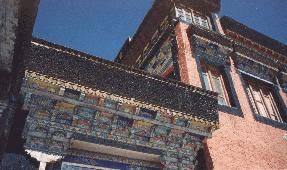
- " Visa for the Tibet " where Alan Winnington speaks about the Lamaism as about the " mechanical religion " considering the work of the classes laborious as owed by simple natural obligation towards the monks who hesitate by no means to become allied to the noble persons to exploit them in a shameless way. The report on the state of needy poverty of the majority of the laymen is striking. The corporal punishments are of a primary inhumanity...
- " The initiation, the journey at the last Tibetan llamas " in which André Chaleil holds similar comments: " And, certainly, one wonders to notice in which point the agnostic original Buddhism and athéiste was able to be transformed, in the outside forms at least, in the contact of the Tibetan people, to give place to this stifling religion so much she is complex: the bouddho-tantrisme, otherwise called the Lamaism... The theocracy of the Dalai Lama, it, melts itself on a religious notion of the existence, always fascinating for the Tibetan... "
André Padoux dedicates a long paragraph to the Lamaism: (p. 372 and f.): in the book " Aux sources du Bouddhisme " of Lilian Silburn:
" But the Lamaism has nevertheless an appropriate aspect, because it stressed certain tantrics features and, especially, integrated many elements belonging to the faiths which existed before him (or coexisted with him) in the Tibet. It is moreover of such elements, sometimes hardly boudhaised, that, more than the learned Lamaism, form the reality of the Tibetan religion... The Lamaism, indeed, reserves the activity cleanly religious to the specialists - monks or hermits - whose believers orregular customers restrict to ask for the intervention, without, mostly, to assist themselves the rites either ceremonies, moreover long and complex, or secret... If, however, one asks to the believers or regular customers only to donate in the church and in the poor men and to lead a moral life, to accumulate the merits to be reborn in a better later existence; Only, indeed, the total submission to the boss, and especially the faith, can give the run-up of all the indispensable being to escape the illusion of the me and reach the nirvâna... "
Finally, William Cerf, in a recent article of the Express of July 30, 98, a paper:
" Finally, and it is not the slightest of the paradoxes, many emulators of the " postmodern " Buddhism declare themselves captivated by the Tibetan rites. It turns out that the Tibetan Buddhism is a branch very esotéric, said Vajrayana or Vehicle of diamond. Endowed with a hardly elaborated rite - which takes this time a determinedly religious character - and of a specific institution - the superiority of the Dalai Lama on his people - the Tibetan religion is very remote from the original education of the Buddha. She covers notably a magic, supernatural character, which requires a long initiation... "
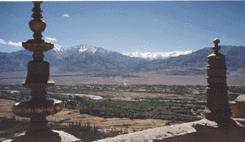
Having given the word to these authors (among the others) who assume the whole responsibility of their comments, let us return to the present. When the current Dalai Lama, become by the force of the tragic events which one knows, the hierarchical leader spiritually and temporarily politics of the Tibetan - in exile or stayed in the country - deduces that he is only a Buddhist monk, he is it only in the circumstances where he teaches and puts into practice the initial Educations of the Buddha and that he forces itself in the rules of the monachal life expressed in Vinaya, et cetera - ceremonial and ritual miscellaneous, initiations - is within the competence only of a Lamaism term employed by ADN who has the peculiarity to irritate fairly the Dalai Lama, and in which, although llama itself, he emits strong hesitations to belong to it... of the most occult and has nothing to do with the initial Buddhism.
For example, the initiation of Kalachakra (the highest and most subtle I' initiation, that of the Wheel of Time, distributed on different occasions by the Dalai Lama, in corpore), with its five floors filled(performed) with divinities (on the whole 722 ! whose major part arises from the inheritance Indian tantrique) the impermanence of its destruction has nothing of Buddhist, to part exclusively... And even if it refers in the second floor, dedicated to the Word, to the qualities contained in the Education of the Buddha, this floor welcomes nevertheless 116 divinities of which one finds any track in the fundamental soutrâs of the Buddha, these excluding any representation, even imaginative of a some divinity.
One forgets too easily as well, proofs and texts in the support as the Dalai Lama ( guéloupa ) is only the leader, hierarchically, temporal while Panchen-Lama (or Tachi-lama) considered as reincarnation of the bouddha Amitâbha), authority established by the Dalai Lama himself, is, him, the real spiritual leader. ADN underlines in lamaïques Initiations: " Dalaïs-lamas, as sovereigns of the Tibet (provinces of U and of Tsang, those of Amdo and remaining Kham semi-independent) are a political Chinese creation! " (Sakyas had occupied this function before being dethroned it by Gélugpas).
But, as the personality of the current Dalai Lama (native of Amdo...) Nobel prize of the Peace, etc. is so impressive, one forgets this point of the " Tibetan standard cannon" which exists, well and truly , for several centuries. Moreover, it is to underline that connections among these two dignitaries were always not openly cordial, not to say hostile. It is unmistakable that following the example of the other treated on a hierarchical basis religions, the spirituality is obliterated by these " hierarchical artillery " heavy and congealed in their structures and especially in the affection in the protection of their experiences.
All the books dedicated in the Tibet by Alexandra David-Neel, implied observer, highlight objectively the magic character of this "religion" that she agrees to call the Lamaism (term refuted by the Dalai Lama, himself, recognized all over the world in spite of as the supreme Llama, confirmed in the head of this religious system) and which has nothing of common or even very little with the Buddhism.
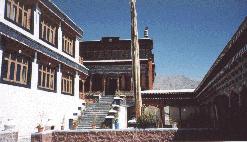 Tantrisme (as its word
indicates it there sanscrit, namely: texture, thread weaved horizontally and
vertically), under different forms that it is Mantrayâna, Mûdrayâna,
Mandalayâna, leans on texts for the broadcasting(distribution)
and the distribution of a knowledge horizontally in the space and vertically in
the time. The character ésotérique and secret results from the fact that
the understanding of the rites and the practices, in occult and magic
connotation with the aim of the obtaining powers and of the putting at
disposition of divinities and forces extra-or superhuman, requires a
capable spirit, arranged and formed by a special education, where from already
at first a nuance sure of selectivity, little compatible with the universal
condolence...
Tantrisme (as its word
indicates it there sanscrit, namely: texture, thread weaved horizontally and
vertically), under different forms that it is Mantrayâna, Mûdrayâna,
Mandalayâna, leans on texts for the broadcasting(distribution)
and the distribution of a knowledge horizontally in the space and vertically in
the time. The character ésotérique and secret results from the fact that
the understanding of the rites and the practices, in occult and magic
connotation with the aim of the obtaining powers and of the putting at
disposition of divinities and forces extra-or superhuman, requires a
capable spirit, arranged and formed by a special education, where from already
at first a nuance sure of selectivity, little compatible with the universal
condolence...
This tantrisme is a mixture stemming from the imported Hinduism, from the Taoïsme and of pre-existent Bön; therefore, it(he) has only very tiny connections with the initial and essential Buddhism, otherwise anybody. Not to forget as well as the clergy, whatever religion it is, always tried to strike the imagination of its flocks better to exercise its temporal power; in that case handbook, all these divinities are Calls to order... The reading its hardly interesting " Buddha's Buddhism " is to recommend warmly to clarify the ideas.
As explains it very well Alexandra David-Neel, and as confirmed it very vén. Kalou Rinpoché, and as the vén has just repeated it recently. Dhagpo rinpoché, both authentic masters, it is imperative to have robust basic notions of the Buddhism, even excellent, that it is of Théravâda and Mahâyâna, before to want or even to manage to interfere in the maze of the practices Tibetan tantriques; exclusively feasible and efficient practices, of a stabilisante way, by and for persons who gave evidence of patience and perseverance in their learning of these aforesaid Buddhist knowledge, indispensable to the acquisition of the adequate levels of consciousness and difference. It requires from very numerous years of listening, work, training, without any haste, nor vague desire of immediate and tangible results. The Buddhism is not and will not never be a " spiritual Fast food restaurant " in " Méga-souk of spiritual Business " that one is completely aware of it!
******
The U.B.L.F is anxious sincerely to underline that the "Tibetan" Buddhism, in what it has of really and authentically Buddhist and which is or should be the major part of its educations, this Buddhism is very rich in sensible, relevant explanatory methods and favorable to the Road towards the Awakening, even excellently profitable for every person in search for the understanding of its Inside.
The last stay ( 1997 ) of the Dalai Lama in France, to Karma-Ling, was dedicated to the 4 Noble Truths, its education tantrique was remarkable, authentic in the explanation and of a very high spirituality, not. What proves that he can distribute an education of very big Buddhist value and especially very bare, because given onto " originally " essential bases.

Then, in consideration of the fascination of the multiple facets of the Buddhism, Himalayan besides, indeed discern between original and fundamental Buddhism and what is only pure rites and tantriques, even magic practices. Not to attribute them to the Buddhism, let them attribute or be allowed it convince, by succumbing even artlessly to certain laughter and smiles!
What makes that the U.B.L.F goes by no means there against the Tibetan Buddhism, as long as it does not impose on the interested or western followers, in any way:
- An imitation of exotic and abstruse rites which belong on no account to the unconscious, either collective or individual, western, imitation condemned by the Buddha himself in his soûtras last ones,
- Initiations for whom the majority of the " believersor regular customers) in power " are neither prepared at all really, nor predisposed in their collective and individual unconscious, at first , to face the energies there concerned, the energies which belong by no means to the western spiritual and religious culture, or then to manage them really completely and\or harmoniously in a second time.
- Finally the learning of the Tibetan, " to understand(include) better the spiritual essence " rites and educations. Their translated "correspondences" do not there remain less burdened referentially of an underlying Judeo - Christian linguistic imprint culturally. It's the same for people who learn the sanscrit, the turned pale, the Chinese, Japanese... To be better penetrated of her(it) " susbstantifique moëlle semantics " with soûtras, intellectualizing as one pleases the understanding and the application of and according to the Spirit of the Buddha, which do not require of it, far from there!
*******
NdUBLF: In the fact how many Buddhists are there completely conscious during the recitation either of Chom dän dä my she rap kyi ..., or of Mahâ Prajñâpâramitâ soûtra or the Maka Hanna Haramita Shingyo ...? (Various naming what one called, wrongly , the soûtra of the Heart, while the just word is there soûtra some Essence of the Perfection of the supreme Wisdom).
It is for it that we recite it to every consideration of Monday evening in the Centre " Peace of the Spirit ", sits of the U.B.L.F, in French, and not in some imitation linguistic exotiquement endorsing the " thirst of insatiable one disorientation " or the eruditionnal self-satisfaction " of spiritual intellectuals "; this to full with it profoundly our conscious and our unconscious which meet themselves there completely and essentially. Without wanting to make of extrapolation, let us remind that the council Vatican II had lauded a return in the autochtonous language, even the idiom, practised by the believers or regular customers), snapping finger at the perpetual " Latin of church "...
******
To end, there is, as everywhere, a plethoric of little-feet gurus attractive, eager or full generally known manipulators and some true authentic bosses; these last ones are rare and discreet, in spite of the fact that they are very popular. Among these, a Tibetan Grand Master, on visit in a Tibetan convent in West, was pressing emphatically, by western followers, to give educations onto the Tibetan Buddhism. As he refused itself there with a lot of kindness, it was asked to him to explain itself on its silence. He answered by smiling:
" I came to see the monks, my fellow countrymen and the coreligionists Buddhists and teach them the Tibetan Buddhism. Now, you, dear western friends, you are neither my fellow countrymen, nor my coreligionists! So, I may not teach you the Tibetan Buddhism... On the other hand, the words of the Buddha concern to you all and it is the only education that I can authentically distribute you. "
To you to appreciate the honesty of this answer...